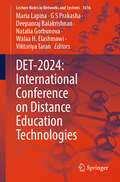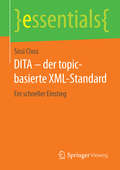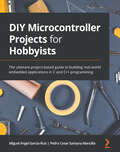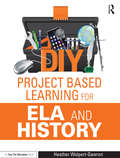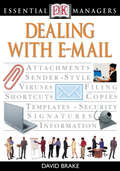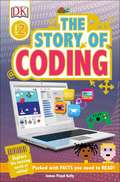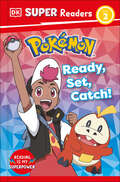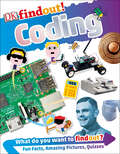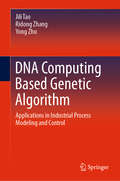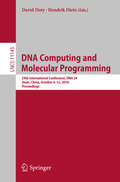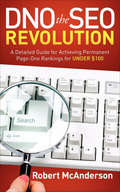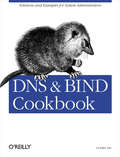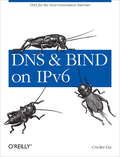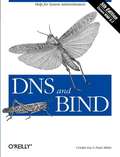- Table View
- List View
DET-2024: International Conference on Distance Education Technologies (Lecture Notes in Networks and Systems #1616)
by Maria Lapina G S Prakasha Deepanraj Balakrishnan Natalia Gorbunova Walaa H. Elashmawi Viktoriya TaranThis book contains the papers presented at the DET-2024: International Conference on Distance Education Technologies, which was held in Russia at the Vernadsky Federal University and North Caucasus Federal University on September 17–19, 2024, and online. The aims are bringing together leading researchers, academics, and practitioners in the fields of education and teaching. The conference aims to provide a platform for the exchange of ideas and the presentation of research findings in these important areas of study. The aims are at bringing together researchers, teachers, industries, practitioners from education, information technologies, artificial intelligence, digital pedagogy, digital educational environment, e-learning, gamification, augmented and virtual reality fields to present recent innovations, find topics of common interest, and stimulate further development of new approaches. The book serves as a valuable platform for scholars, practitioners, and students interested in the latest advancements in information security management and applications. It provides an opportunity to expand knowledge, establish connections with peers, and contribute to the further advancement of the field. The book promises to be an engaging and informative for those passionate about distance learning technologies and its various applications.
DHCP for Windows 2000
by Neall AlcottDHCP for Windows 2000 is custom-designed for system administrators who are responsible for configuring and maintaining networks with Windows 2000 servers. It explains the DHCP protocol and how to install and manage DHCP on both servers and clients--including client platforms other than Windows 2000.
DHCP for Windows 2000
by Neall AlcottDynamic Host Configuration Protocol (DHCP) is an open standard Internet protocol used to allocate and manage IP addresses dynamically. Before DHCP came along, administrators had to manually configure each host on a network with an IP address, subnet mask, and default gateway. Maintaining the changes and the associated logs took a tremendous amount of time and was prone to error. DHCP uses a client/server model in which the system updates and maintains the network information dynamically. Windows 2000 provides enhanced DHCP client-server support. DHCP for Windows 2000 is custom-designed for system administrators who are responsible for configuring and maintaining networks with Windows 2000 servers. It explains the DHCP protocol and how to install and manage DHCP on both servers and clients--including client platforms other than Windows 2000. Readers get detailed and explicit instructions for using Windows 2000 DHCP to manage their network IP configurations much more efficiently and effectively.They get background information for using DHCP in general, plus complete information about the Windows 2000 use of DHCP. For those interested in what's on the horizon, the author steps up to the plate with an analysis of the future direction of DHCP and Windows support for IPv6.
DITA - der topic-basierte XML-Standard: Ein schneller Einstieg (essentials)
by Sissi ClossPrägnant und praxisorientiert erfahren Sie hier, auf welchen zentralen Prinzipien DITA beruht. Die wichtigsten DITA-Features werden anhand einfacher Beispiele erklärt, die direkt auf die eigene Umgebung übertragbar sind. Damit ist dieses essential ein guter Einstieg für alle, die DITA noch nicht kennen, und ideal als erste Entscheidungshilfe, wenn es um die Optimierung einer Informationslandschaft geht.
DITA for Practitioners Volume 1
by Eliot KimberDITA expert Eliot Kimber takes you inside the DITA XML standard, explaining the architecture and technology that make DITA unique. Volume 1 of his two-volume exploration of DITA starts with a hands-on explanation of end-to-end DITA processing that will get you up and running fast. Then, he explores the DITA architecture, explaining maps and topics, structural patterns, metadata, linking and addressing, keys and key references, relationship tables, conditional processing, reuse, and more. DITA for Practitioners Volume 1: Architecture and Technology is for engineers, tool builders, and content strategists: anyone who designs, implements, or supports DITA-based systems and needs a deeper understanding of DITA technology. Kimber's unique perspective unwraps the puzzle that is DITA, explaining the rationale for its design and structure, and giving you an unvarnished, detailed look inside this important technology.
DIY Coffee: Coffee Roaster, Bottomless Portafilter, Toaster Tea Popper, Hot on the Spot, Automate Using X10
by Mark FrauenfelderDIY Coffee collects five hot MAKE magazine projects to supercharge your java: Home-Built Coffee Roaster Bottomless Espresso Portafilter Toaster Tea Popper Perfect Espresso Temperature Hack Web-Fired Coffee with X10 AutomationGot a jones for caffeine and technology? Mod your espresso machine to dial in the perfect shot, with precise temperature control and a filter hack that kicks out maximum tasty crema. Roast your own with a hand-built custom coffee roaster. Hack a toaster timer to perfect-brew your tea every time. And fire up your coffee pot from the internet using X10 automation. Using home-grown techniques and off-the-shelf parts, caffeine junkies will find everything they need to overclock the fix from their favorite shade-grown beverage.
DIY Microcontroller Projects for Hobbyists: The ultimate project-based guide to building real-world embedded applications in C and C++ programming
by Miguel Angel Garcia-Ruiz Pedro Cesar MancillaA practical guide to building PIC and STM32 microcontroller board applications with C and C++ programmingKey FeaturesDiscover how to apply microcontroller boards in real life to create interesting IoT projectsCreate innovative solutions to help improve the lives of people affected by the COVID-19 pandemicDesign, build, program, and test microcontroller-based projects with the C and C++ programming languageBook DescriptionWe live in a world surrounded by electronic devices, and microcontrollers are the brains of these devices. Microcontroller programming is an essential skill in the era of the Internet of Things (IoT), and this book helps you to get up to speed with it by working through projects for designing and developing embedded apps with microcontroller boards. DIY Microcontroller Projects for Hobbyists are filled with microcontroller programming C and C++ language constructs. You'll discover how to use the Blue Pill (containing a type of STM32 microcontroller) and Curiosity Nano (containing a type of PIC microcontroller) boards for executing your projects as PIC is a beginner-level board and STM-32 is an ARM Cortex-based board. Later, you'll explore the fundamentals of digital electronics and microcontroller board programming. The book uses examples such as measuring humidity and temperature in an environment to help you gain hands-on project experience. You'll build on your knowledge as you create IoT projects by applying more complex sensors. Finally, you'll find out how to plan for a microcontroller-based project and troubleshoot it. By the end of this book, you'll have developed a firm foundation in electronics and practical PIC and STM32 microcontroller programming and interfacing, adding valuable skills to your professional portfolio.What you will learnGet to grips with the basics of digital and analog electronicsDesign, build, program, and test a microcontroller-based systemUnderstand the importance and applications of STM32 and PIC microcontrollersDiscover how to connect sensors to microcontroller boardsFind out how to obtain sensor data via codingUse microcontroller boards in real life and practical projects Who this book is forThis STM32 PIC microcontroller book is for students, hobbyists, and engineers who want to explore the world of embedded systems and microcontroller programming. Beginners, as well as more experienced users of digital electronics and microcontrollers, will also find this book useful. Basic knowledge of digital circuits and C and C++ programming will be helpful but not necessary.
DIY Project Based Learning for ELA and History
by Heather Wolpert-GawronAre you interested in using Project Based Learning to revamp your lessons, but aren’t sure how to get started? In DIY Project Based Learning in ELA and History, award-winning teacher and Edutopia blogger Heather Wolpert-Gawron makes it fun and easy! Project Based Learning encourages students and teachers alike to abandon their dusty textbooks, and instead embrace a form of curriculum design focused on student engagement, innovation, and creative problem-solving. A leading name in this field, Heather Wolpert-Gawron shares some of her most popular units for ELA and Social Studies in this exciting new collection. This book is an essential resource for teachers looking to: Create their own Project Based Learning units. Engage student in their education by grounding lessons in real-world problems and encouraging them to develop creative solutions. Incorporate role-playing into everyday learning. Develop real-world lessons to get students to understand the life-long relevance of what they are learning. Assess multiple skills and subject areas in an integrated way. Collaborate with teachers across subject areas. Test authentic skills and set authentic goals for their students to grow as individuals. Part I of the book features six full units, complete with student samples, targeted rubrics, a checklist to keep students on track, and even "Homework Hints." Part II is a mix-and-match section of tools you can use to create your own PBL-aligned lessons. The tools are available as eResources on our website, http://www.routledge.com/books/details/9781138891623, so you can print and use them in your classroom immediately.
DK Essential Managers: Dealing With E-mail (DK Essential Managers)
by David BrakeThe way you manage your e-mail affects your efficiency at work. Learn to make optimum use of your e-mail software so that it helps you to function in an organized manner. The DK Essential Managers series covers a range of business and management topics and has sold more than two million copies worldwide. Each guide is clearly presented for ease of reference, with visual pointers, tips, and graphics.
DK Essential Managers: The Digital Revolution (DK Essential Managers)
by DKLike it or not, the digital revolution has swept the business world and, no matter how good you are at your job, if you don't have the technical tools to keep up you'll be left behind. Luckily, The Digital Revolution is here to get you up to speed and get the jump on the competition.The DK Essential Managers series covers a range of business and management topics and has sold more than two million copies worldwide. Each guide is clearly presented for ease of reference, with visual pointers, tips, and graphics.
DK Readers L2: Story of Coding (DK Readers Level 2)
by James Floyd KellyDiscover the history of computers and coding. From Ada Lovelace's initial idea of computer programming to today's coding languages like Scratch, Python, Javascript, and more.This reading book for kids explores the world of coding while building reading skills and teaching exciting vocabulary. Packed with photographs, diagrams, fun facts, and strong visual clues to keep your little ones engaged.What exactly is a computer? How do they work? What is a code? What are the different coding languages? This beginner's reader explores it all and more! Young children will find out what coding is, how it developed, and how modern codes are used for everyday purposes.It's the perfect reading book for ages 5-7 who are starting to read fluently with support. Level 2 titles contain carefully selected photographic images to complement the text, providing strong visual clues to build vocabulary and confidence. Additional information spreads are full of extra fun facts, developing the topics through a range of nonfiction presentation styles such as diagrams and activities.Explore, Engage, And Learn!There's a message for readers to decode, plus tips for writing their own code with child-friendly Scratch programming. This kid's educational book explores the world of coding and is full of facts kids will love reading.While learning to read, kids will also: - Learn about what coding is - Explore the world of early computers- Discover coding languages and coding today- Enjoy cool coding tips and test their knowledgeTrusted by parents, teachers, and librarians, and loved by kids, DK's leveled series of kids reading books is now revised and updated. With shiny new jackets and brand-new nonfiction narrative content on the topics kids love, each book is written and reviewed by literacy experts and contains a glossary and index, making them the perfect choice for helping develop strong reading habits for kids ages 3-11. Add other Level 2 titles to your collection covering a range of topics like LEGO City: Heroes to the Rescue: Find Out How They Keep the City Safe, What Is An Election?, Hello Hedgehog, Amazing Bees, Life In The Stone Age, many Star Wars titles and more.
DK Readers L2: Story of Coding (DK Readers Level 2)
by James Floyd KellyDiscover the history of computers and coding. From Ada Lovelace's initial idea of computer programming to today's coding languages like Scratch, Python, Javascript, and more.This reading book for kids explores the world of coding while building reading skills and teaching exciting vocabulary. Packed with photographs, diagrams, fun facts, and strong visual clues to keep your little ones engaged.What exactly is a computer? How do they work? What is a code? What are the different coding languages? This beginner's reader explores it all and more! Young children will find out what coding is, how it developed, and how modern codes are used for everyday purposes.It's the perfect reading book for ages 5-7 who are starting to read fluently with support. Level 2 titles contain carefully selected photographic images to complement the text, providing strong visual clues to build vocabulary and confidence. Additional information spreads are full of extra fun facts, developing the topics through a range of nonfiction presentation styles such as diagrams and activities.Explore, Engage, And Learn!There's a message for readers to decode, plus tips for writing their own code with child-friendly Scratch programming. This kid's educational book explores the world of coding and is full of facts kids will love reading.While learning to read, kids will also: - Learn about what coding is - Explore the world of early computers- Discover coding languages and coding today- Enjoy cool coding tips and test their knowledgeTrusted by parents, teachers, and librarians, and loved by kids, DK's leveled series of kids reading books is now revised and updated. With shiny new jackets and brand-new nonfiction narrative content on the topics kids love, each book is written and reviewed by literacy experts and contains a glossary and index, making them the perfect choice for helping develop strong reading habits for kids ages 3-11. Add other Level 2 titles to your collection covering a range of topics like LEGO City: Heroes to the Rescue: Find Out How They Keep the City Safe, What Is An Election?, Hello Hedgehog, Amazing Bees, Life In The Stone Age, many Star Wars titles and more.
DK Readers Level 2: The Story of Coding, First American Edition
by James Floyd KellyThis book is part of an exciting four-level reading series for children, developing the habit of reading widely for both pleasure and information. These chapter books have a compelling main narrative to suit your child's reading ability. Each book is designed to develop your child's reading skills, fluency, grammar awareness, and comprehension in order to build confidence and engagement when reading.
DK Super Readers Level 1 Pokemon Sweet Surprise!
by DKBoost your reading skills as you meet a cute collection of kind and caring Pokémon with this fun-filled Level 1 reader, carefully leveled to help children learn to read.Did you know that a Togepi will share good luck when treated kindly? Or that a dessert decorated by an Alcremie will bring happiness to all who eat it? Learn all about these sweet Pokémon, their surprising skills, and more in this Level 1 Super Reader!The engaging text has been carefully leveled using Lexile so that children are set up to succeed. Colorful Pokémon images, clear vocabulary, and a fun quiz will help young readers build their reading ability as they read about the friendly Pokémon.The DK Super Readers series can help your child practice reading by:Covering engaging, motivating, curriculum-aligned topics.Building knowledge while progressing core Grade 1 and 2 reading skills.Developing subject vocabulary on popular topics, including the world of Pokémon.Boosting understanding and retention through comprehension quizzes.Each title, which has been leveled using MetaMetrics®: The Lexile Framework for Reading, integrates science, geography, history, nature, and popular fiction topics, so there’s something for all children’s interests. DK Super Readers Level 1 titles are visually engaging and expand subject knowledge and vocabulary, perfect for helping children aged 6 to 8 (Grades 1 and 2) who are learning to read with help.
DK Super Readers Level 2 Pokemon Ready, Set, Catch!
by DKBoost your reading skills and uncover the secrets of catching Pokémon with this fun-filled Level 2 reader, carefully leveled to help children learn to read.Where do Pokémon hide, and how can you catch them? All is revealed in Ready, Set, Catch! Meet Liko, Roy, and friends from Pokémon Horizons: The Series as you learn about Poké Balls, Pokémon Trainers, winning battle moves, and more. It’s all you need to find and catch your very own Pokémon!The engaging text has been carefully leveled using the Lexile reading scheme so that children are set up to succeed. Colorful Pokémon images, clear vocabulary, and a fun quiz will help young readers build their reading ability and confidence as they learn about finding and caring for Pokémon.The DK Super Readers series can help your child practice reading by:Covering engaging, motivating, curriculum-aligned topics.Building knowledge while progressing Grades 2 and 3 reading skills.Developing subject vocabulary on popular topics, including the world of Pokémon.Boosting understanding and retention through comprehension quizzes.Each title, which has been leveled using MetaMetrics®: The Lexile Framework for Reading, integrates science, geography, history, nature, and popular fiction topics, so there’s something for all children’s interests. DK Super Readers Level 2 titles are visually engaging and expand subject knowledge and vocabulary, perfect for helping children aged 7 to 9 (Grades 2 and 3) begin to read independently.
DKfindout! Coding (DK findout!)
by DKSupporting STEM-based learning, this fun, fact-filled book for kids ages 6–9 explores the programming that makes our world work, in everyday objects from traffic lights to vending machines. Educating young readers through a combination of close-up images, quirky trivia facts, quiz questions, and fascinating tidbits, it&’s the perfect book for any reader who can&’t get enough of coding.How much did the first laptop weigh? What exactly is a computer bug? How many calculations can the world&’s fastest computer perform in a single second? Find out the answers to these questions and more in DKfindout! Coding, which features photographs and illustrations of gadgets, games, and coding geniuses like Ada Lovelace and Alan Turing. Beginning in the mid-1800s, readers can trace the path of coding pioneers from the birth of the first computer all the way to today&’s tech boom. Along the way, they&’ll learn about the fundamentals of coding languages like Java and Python—including their application in everything from cars to calculators—and how coding continues to revolutionize tech, gaming, medicine, space travel, and more.Vetted by educational consultants, the DKfindout! series drives kids ages 6–9 to become experts on more than 30 of their favorite STEM- and history-related subjects, whether Vikings, volcanoes, or robots. This series covers the subjects that kids really want to learn about—ones that have a direct impact on the world around them, like climate change, space exploration, and rapidly evolving technology—making learning fun through amazing images, stimulating quizzes, and cutting-edge information. The DKfindout! series is one that kids will want to turn to again and again.
DNA Computing Based Genetic Algorithm: Applications in Industrial Process Modeling and Control
by Yong Zhu Ridong Zhang Jili TaoThis book focuses on the implementation, evaluation and application of DNA/RNA-based genetic algorithms in connection with neural network modeling, fuzzy control, the Q-learning algorithm and CNN deep learning classifier. It presents several DNA/RNA-based genetic algorithms and their modifications, which are tested using benchmarks, as well as detailed information on the implementation steps and program code. In addition to single-objective optimization, here genetic algorithms are also used to solve multi-objective optimization for neural network modeling, fuzzy control, model predictive control and PID control. In closing, new topics such as Q-learning and CNN are introduced. The book offers a valuable reference guide for researchers and designers in system modeling and control, and for senior undergraduate and graduate students at colleges and universities.
DNA Computing and Molecular Programming: 23rd International Conference, DNA 23, Austin, TX, USA, September 24–28, 2017, Proceedings (Lecture Notes in Computer Science #10467)
by Robert Brijder and Lulu QianThis book constitutes the refereed proceedings of the 23th International Conference on DNA Computing and Molecular Programming, DNA 23, held Austin, TX, USA, in September 2017. The 16 full papers presented were carefully selected from 23 submissions. Research in DNA computing aims to draw together mathematics, computerscience, physics, chemistry, biology, and nanotechnology to address the analysis, design, and synthesis of information-based molecular systems. The papers address all areas related to biomolecular computing such as: algorithms and models for computation with biomolecular systems; computational processes in vitro and in vivo; molecular motors and molecular robotics; studies of fault-tolerance and error correction; software tools for analysis, simulation, and design; synthetic biology and in vitro evolution; applications in engineering, physics, chemistry, biology, and medicine.
DNA Computing and Molecular Programming: 24th International Conference, DNA 24, Jinan, China, October 8–12, 2018, Proceedings (Lecture Notes in Computer Science #11145)
by David Doty Hendrik DietzThis book constitutes the refereed proceedings of the 24th International Conference on DNA Computing and Molecular Programming, DNA 24, held in Jinan, China, in October 2018. The 12 full papers presented were carefully selected from 14 submissions. Research in DNA computing aims to draw together mathematics, computer science, physics, chemistry, biology, and nanotechnology to address the analysis, design, and synthesis of information-based molecular systems. The papers were sought in all areas related to biomolecular computing, including: algorithms and models for computation on biomolecular systems; computational processes in vitro and in vivo; molecular switches, gates, devices, and circuits; molecular folding and self-assembly of nanostructures; analysis and theoretical models of laboratory techniques; molecular motors and molecular robotics; information storage; studies of fault tolerance and error correction; software tools for analysis, simulation, and design; synthetic biology and in vitro evolution; and applications in engineering, physics, chemistry, biology, and medicine.
DNA Computing and Molecular Programming: 25th International Conference, DNA 25, Seattle, WA, USA, August 5–9, 2019, Proceedings (Lecture Notes in Computer Science #11648)
by Yan Liu Chris ThachukThis book constitutes the refereed proceedings of the 25th International Conference on DNA Computing and Molecular Programming, DNA 25, held in Seattle, WA, USA, in August 2019.The 12 full papers presented were carefully selected from 19 submissions. The papers cover a wide range of topics relating to biomolecular computing such as algorithms and models for computation on biomolecular systems; computational processes in vitro and in vivo; molecular switches, gates, devices, and circuits; molecular folding and self-assembly of nanostructures; analysis and theoretical models of laboratory techniques; molecular motors and molecular robotics; information storage; studies of fault-tolerance and error correction; software tools for analysis, simulation, anddesign; synthetic biology and in vitro evolution; and applications in engineering, physics, chemistry, biology, and medicine.
DNO the SEO Revolution: A Detailed Guide for Achieving Permanent Page-One Rankings for Under $100
by Robert McAndersonThe total number of searches conducted across all search engines in 2011, will exceed 300 Billion and will cost companies competing for these page-one listings in excess of 50 Billion Dollars. DNO the SEO Revolution is a how-to-guide for achieving Permanent page-one rankings for under $100. This one extraordinarily simple idea will shatter traditional SEO concepts allowing every reader the opportunity to gain multiple Page One Rankings. I know because I have achieved multiple rankings for my own company and a select number of customers who participated in our trials. Achieving the top three listings on Page One of Google for under $100 is an amazing accomplishment but for them to be permanently listed and not be under threat from competitors who are prepared to pay more for the ranked position is extraordinary. The use of SEO, PPC and SEM to achieve a Page One Google Ranking are expensive but more importantly they offer no permanency. Keyword auctions that encourage competitors to pay a higher price for the number one ranked position are insane and it is time to do things differently. Remember Einstein said, “The definition of insanity is doing the same thing over and over again and expecting a different result.” Act now before your competitor does or face the consequences of their domination over you.
DNS & BIND Cookbook: Solutions & Examples for System Administrators
by Cricket LiuThe DNS & BIND Cookbook presents solutions to the many problems faced by network administrators responsible for a name server. Following O'Reilly's popular problem-and-solution cookbook format, this title is an indispensable companion to DNS & BIND, 4th Edition, the definitive guide to the critical task of name server administration. The cookbook contains dozens of code recipes showing solutions to everyday problems, ranging from simple questions, like, "How do I get BIND?" to more advanced topics like providing name service for IPv6 addresses. It's full of BIND configuration files that you can adapt to your sites requirements.With the wide range of recipes in this book, you'll be able toCheck whether a name is registeredRegister your domain name and name serversCreate zone files for your domainsProtect your name server from abuseSet up back-up mail servers and virtual email addressesDelegate subdomains and check delegationUse incremental transferSecure zone transfersRestrict which queries a server will answerUpgrade to BIND 9 from earlier versionPerform logging and troubleshootingUse IPv6and much more.These recipes encompass all the day-to-day tasks you're faced with when managing a name server, and many other tasks you'll face as your site grows. Written by Cricket Liu, a noted authority on DNS, and the author of the bestselling DNS & BIND and DNS on Windows 2000, the DNS & BIND Cookbook belongs in every system or network administrator's library.
DNS and BIND on IPv6: DNS for the Next-Generation Internet
by Cricket LiuIf you're preparing to roll out IPv6 on your network, this concise book provides the essentials you need to support this protocol with DNS. You'll learn how DNS was extended to accommodate IPv6 addresses, and how you can configure a BIND name server to run on the network. This book also features methods for troubleshooting problems with IPv6 forward- and reverse-mapping, and techniques for helping islands of IPv6 clients communicate with IPv4 resources.Topics include:DNS and IPv6—Learn the structure and representation of IPv6 addresses, and the syntaxes of AAAA and PTR records in the ip6.arpa IPv6 reverse-mapping zoneBIND on IPv6—Use IPv6 addresses and networks in ACLs, and register and delegate to IPv6-speaking name serversResolver Configuration—Configure popular stub resolvers (Linux/Unix, MacOS X, and Windows) to query IPv6-speaking name serversDNS64—Learn about the transition technology that allows clients with IPv6-only network stacks to communicate with IPv4 serversTroubleshooting—Use the nslookup and dig troubleshooting tools to look up the IPv6 addresses of a domain name, or reverse-map an IPv6 address to a domain name
DNS and BIND, 4th Edition
by Cricket Liu Paul AlbitzThe fourth edition of DNS and BIND covers the new 9.1.0 and 8.2.3 versions of BIND as well as the older 4.9 version. There's also more extensive coverage of NOTIFY, IPv6 forward and reverse mapping, transaction signatures, and the new DNS Security Extensions; and a section on accommodating Windows 2000 clients, servers and Domain Controllers.
DNS and BIND, 5th Edition
by Cricket Liu Paul AlbitzDNS and BIND tells you everything you need to work with one of the Internet's fundamental building blocks: the distributed host information database that's responsible for translating names into addresses, routing mail to its proper destination, and even listing phone numbers with the new ENUM standard. This book brings you up-to-date with the latest changes in this crucial service. The fifth edition covers BIND 9.3.2, the most recent release of the BIND 9 series, as well as BIND 8.4.7. BIND 9.3.2 contains further improvements in security and IPv6 support, and important new features such as internationalized domain names, ENUM (electronic numbering), and SPF (the Sender Policy Framework). Whether you're an administrator involved with DNS on a daily basis or a user who wants to be more informed about the Internet and how it works, you'll find that this book is essential reading. What DNS does, how it works, and when you need to use it How to find your own place in the Internet's namespace Setting up name servers Using MX records to route mail Configuring hosts to use DNS name servers Subdividing domains (parenting) Securing your name server: restricting who can query your server, preventing unauthorized zone transfers, avoiding bogus servers, etc. The DNS Security Extensions (DNSSEC) and Transaction Signatures (TSIG) Mapping one name to several servers for load sharing Dynamic updates, asynchronous notification of change to a zone, and incremental zone transfers Troubleshooting: using nslookup and dig, reading debugging output, common problems DNS programming using the resolver library and Perl's Net::DNS module Topics include:
